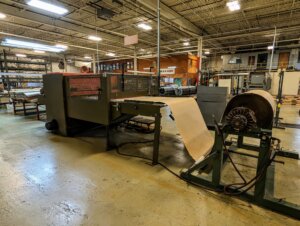The Industrial Die Cutting Machine and Its Uses

What is an industrial die cutting machine?
A lot of the basics behind an industrial die cutting machine’s purpose are right there in the name. Usually, we use an industrial die cutting machine on a commercial level, which means it often has to fulfill orders on a fairly large scale, with a high degree of precision, accuracy, and consistency.
Needless to say, what we need this machine to do specifically is, well—die cut. That means cutting out different types of shapes and designs, based off materials that include paper, foil, rubber, foam, and sheet metal (among other things). The basis for the die cutting process goes back to the nineteenth century, believe it or not. Early manufacturers created what we now think of as an industrial cutter to cut leather for shoes. Needless to say, production was somewhat rudimentary at that time, and has come a long way since.
Now, keep in mind that an industrial die cutting machine differs from smaller scale machines individuals may use for small scale projects. For that reason, many business owners seek out larger machines, which you may have to outsource from a third party. The last thing you want is to make a permanent investment in a machine you need more intermittently as opposed to on a regular basis. Or, perhaps if you do need a die-cutting press on a regular basis, you may still not be ready to make a commitment, due to housing and operational concerns.
It’s important to keep in mind that you have flexibility when using an industrial die cutting machine, and that you can create a process that works for you.
How do we approach the commercial die cutting process?
Although you certainly can’t approach die cutting without the proper equipment, it’s not overly difficult to understand the basic principles behind die cutting. You’ll find a variety of different die cutting methods as you explore further, all of which suit different demands. But all die cutting processes involve feeding, stripping, and cutting. Like we said earlier, the point of die cutting is to punch out designs and shapes in a base material. As the manufacturing industry has evolved, so too has the capacity of the machines involved. Now, you can use precision die cutting to create designs and shapes more complex than ever before.
When we refer to a die cutting press, that’s because the machine very literally uses a press system. Using an assembly, we feed the stock material through the press, which operates at a super high pressure. The higher the pressure, the easier it is for us to achieve the degree of precision we want and need. (You can use a lower pressure process through rotary die cutting, but that must run continuously, at a constant speed.)
The machine we use has a die board, as well as a plate. Using cutting and punching tools, as well as a rubber ejection strip, we achieve the desired result—and can continue doing so repetitively, which is exactly what you want when working on large scale production orders. The degree of detail you’ll find with die cutting results may surprise you. Through die cutting, we make everything from perforated holes to kiss cuts and scores. The sky is the limit!
What kinds of things can we produce through die cutting?
So—what can you produce with an industrial die cutting machine? For that matter, which industries, as a result, have come to rely on these machines over time?
Consider these products, all capable of being made with an industrial die cutting machine:
Cardboard and Carton Packaging
Utilizing cardboard and fiberboard, we produce packaging with a die machine. Think beyond product packaging—envelope mailers, cargo liner components, and bookends all fall under the realm of die cutting production.
Plastic Parts
Yes, we can manipulate plastic with a die cutting machine as well. In this case, we feed thin sheets of plastic into the machines—they can work with those in a way they may not be able to with thicker, heavier pieces of plastic. Typically, we use die cut manufacturing to create plastic hold-downs and stiffeners.
Foam Parts
Speaking of flexibility—you’ll often find that we can use die cutting machines to process foam as well. With die-cut foam, you may find it easier to make rigid foam insulation, too.
Rubber Parts
If you work in the automotive industry, you’ve probably encountered die cut products—like gasoline engine seals, rubber gaskets, and more.
Fabrics and Fibers
Can we use die cutting procedures on fabrics and fibers? Absolutely, we can! We can cut almost every type of fabric. Especially consider materials we use for clothing design, interior décor, and furniture-making.
Clearly, business owners like you encounter many different uses for a process as all-encompassing as die cutting. The key is knowing not only the right process you need, but also the perfect machines to accompany it, and additionally the right way to use them. Fortunately, CTI knows exactly what we’re doing in this realm—and we can help you make the correct calls. Contact us here or dial 419-924-5566 to learn more. We’re always here to assist!
- << < Previous Post
- 1
- 2
- ...
- 26
- ...
- 250
- 251 Next Post > >>

